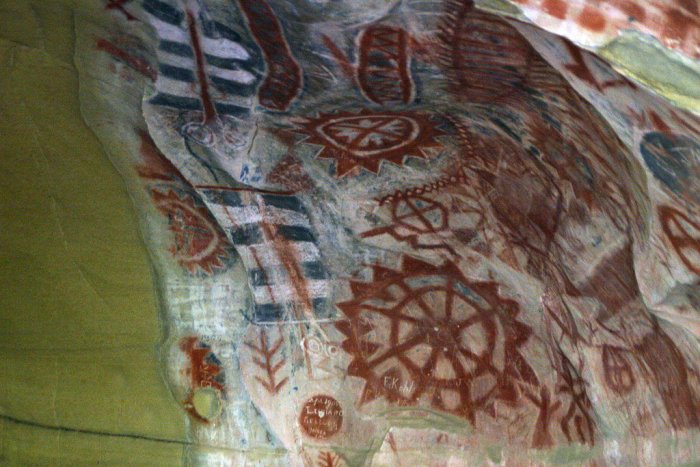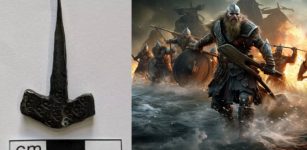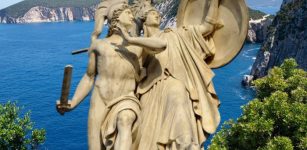Amazing Ancient Chumash Cave Paintings In California Offer Insight Into Ancient Shamanism And Supernatural Beliefs
Ellen Lloyd - AncientPages.com - The ancient Chumash cave paintings are beautiful and simply amazing. Chumash rock art is considered one of the region's most elaborate rock art traditions, and the paintings can be found in many caves and on cliffs in the mountains of southern California, North America.
The cave paintings are very colorful and depict abstract symbols, possibly representing celestial bodies, mythological creatures, animals, and natural phenomena such as, for example, solar eclipses. Many signs and symbols are believed to be part of a religious ritual.
Abstract symbols, possibly representing celestial bodies, mythological creatures, animals, and natural phenomena such as, for example, solar eclipses. Credit: Adobe Stock - Jose
The Chumash people lived in present Santa Barbara, Ventura, and San Luis Obispo between 1300 to 1804 C.E. They were a maritime, hunter-gatherer society whose livelihood was based on the sea. They developed excellent skills for catching fish, shellfish, and other marine mammals. Beyond fishing, however, they were also skilled in creating rock art.
Chumash People And Shamans
The Chumash people shared a special bond with nature. They considered caves, rocks, and water sources very powerful, and their shamans saw them as a "portal to the sacred realm where they could enter the supernatural.
The word shaman originates from the Tungus tribe in Siberia. Anthropologists coined this term and have used it to refer to the spiritual and ceremonial leaders among indigenous cultures worldwide.
Shamanism can be described as the universal spiritual wisdom inherent to all indigenous tribes. As all ancient spiritual practices are rooted in nature, shamanism is how we, as human beings, can strengthen that natural connection.

Painted Cave, Santa Barbara County, California - Image credit: Doc Searls - CC BY-SA 2.0
A shaman interacted with the supernatural by entering a hallucinogenic trance or altered state of consciousness. In this altered state, brought on by surprisingly potent native tobacco or jimsonweed, shamans received visions and supernatural power from spirit helpers, often in the forms of dangerous and powerful animals like rattlesnakes and grizzly bears.
Spirit helpers rarely took the form of an animal that was an important food source because it was 'taboo for a shaman to eat meat from the species of his helper.'
Myths And Legends Of The Chumash People
Like all ancient people, the Chumash had myths and legends about the world's creation, the first humans, and sacred places. These ancient stories were passed on verbally from one generation to the next for thousands of years before the advent of written language. Tales were often told around the fire in the evening for entertainment.
The Chumash people believed we live in one of three worlds. The two other worlds are below and above us, we are in the middle world. There are two serpents that hold our world up from below. When they are tired they move, and that causes earthquakes.
The world above is sustained by the great eagle. He is motionless and always in the same spot. When he gets tired of sustaining the upper world, he stretches his wings a little, and this causes the phases of the moon. When there is an eclipse of the moon it is because his wings cover it completely. And the water in the springs and streams of this earth is the urine of the many frogs that live in it.
The beautiful cave paintings are thought to have been created by Chumash priests to influence supernatural beings and forces to intervene in human affairs.
Updated on September 18, 2024
Written by - Ellen Lloyd – AncientPages.com
Copyright © AncientPages.com All rights reserved. This material may not be published, broadcast, rewritten or redistributed in whole or part without the express written permission of AncientPages.com
Expand for referencesMore From Ancient Pages
-
 Ancient Jericho – City Of Giants And Home Of The Mighty Gibborim
Biblical Mysteries | Jun 28, 2017
Ancient Jericho – City Of Giants And Home Of The Mighty Gibborim
Biblical Mysteries | Jun 28, 2017 -
 Ancient Mystery Of Egypt’s Black Pyramid – Did It Really Exist?
Featured Stories | Nov 28, 2020
Ancient Mystery Of Egypt’s Black Pyramid – Did It Really Exist?
Featured Stories | Nov 28, 2020 -
 Thor’s Hammer Pendant Found In Norfolk May Be Linked To The Great Heathen Army
Archaeology | Oct 24, 2023
Thor’s Hammer Pendant Found In Norfolk May Be Linked To The Great Heathen Army
Archaeology | Oct 24, 2023 -
 Astronomically Aligned Temples And Pyramids Of Ancient World
Featured Stories | Dec 10, 2021
Astronomically Aligned Temples And Pyramids Of Ancient World
Featured Stories | Dec 10, 2021 -
 On This Day In History: Scottish Hero William Wallace Who Met Horrible Death – Is Still Remembered – August 23, 1305
News | Aug 23, 2016
On This Day In History: Scottish Hero William Wallace Who Met Horrible Death – Is Still Remembered – August 23, 1305
News | Aug 23, 2016 -
 Chilling Graffiti Found In 1,600-Year-Old Roman Prison In Corinth, Greece
Archaeology | Aug 19, 2024
Chilling Graffiti Found In 1,600-Year-Old Roman Prison In Corinth, Greece
Archaeology | Aug 19, 2024 -
 Ancient Secrets Of Iberian Warrior Vase – 2,000-Year-Old Masterpiece Of Art
Archaeology | Dec 5, 2017
Ancient Secrets Of Iberian Warrior Vase – 2,000-Year-Old Masterpiece Of Art
Archaeology | Dec 5, 2017 -
 On This Day In History: Napoleon Bonaparte Dies In Exile – On May 5, 1821
News | May 5, 2016
On This Day In History: Napoleon Bonaparte Dies In Exile – On May 5, 1821
News | May 5, 2016 -
 Was Pocahontas A Real Historical Person?
Featured Stories | Feb 20, 2019
Was Pocahontas A Real Historical Person?
Featured Stories | Feb 20, 2019 -
 Avraga In Eastern Mongolia Was Winter Base Camp Of Genghis Khan – Study
Archaeology | Jul 8, 2020
Avraga In Eastern Mongolia Was Winter Base Camp Of Genghis Khan – Study
Archaeology | Jul 8, 2020 -
 Researchers Find Oldest Evidence Of Human-Caused Lead Contamination In Aegean Region
Archaeology | Feb 4, 2025
Researchers Find Oldest Evidence Of Human-Caused Lead Contamination In Aegean Region
Archaeology | Feb 4, 2025 -
 Unknown History Of Gigantic Obelisks Created With Ancient Lost Technology
Ancient Mysteries | Oct 8, 2017
Unknown History Of Gigantic Obelisks Created With Ancient Lost Technology
Ancient Mysteries | Oct 8, 2017 -
 Mysterious Unknown Strange-Looking Ancient Seafarers – Survivors Of A Now Vanished Race?
Ancient Mysteries | Oct 11, 2022
Mysterious Unknown Strange-Looking Ancient Seafarers – Survivors Of A Now Vanished Race?
Ancient Mysteries | Oct 11, 2022 -
 Cimmerians – Ancient People Searching For A Home
Civilizations | Feb 11, 2019
Cimmerians – Ancient People Searching For A Home
Civilizations | Feb 11, 2019 -
 Sailor’s Strange Discovery Of An Unknown Ancient Underground World At The North Pole
Featured Stories | Feb 10, 2024
Sailor’s Strange Discovery Of An Unknown Ancient Underground World At The North Pole
Featured Stories | Feb 10, 2024 -
 Guardians Of The Mounds – Battle To Save Scythian Burial Mounds From Destruction Continues
Archaeology | May 11, 2021
Guardians Of The Mounds – Battle To Save Scythian Burial Mounds From Destruction Continues
Archaeology | May 11, 2021 -
 290-Million-Year-Old Bird-Like Footprints Left By Unknown Animals Found In Africa
Fossils | Nov 30, 2023
290-Million-Year-Old Bird-Like Footprints Left By Unknown Animals Found In Africa
Fossils | Nov 30, 2023 -
 Odd Encounter With A Mysterious Cave-Dwelling Creature Who Issued A Warning Described In A Norse Saga
Featured Stories | Feb 27, 2025
Odd Encounter With A Mysterious Cave-Dwelling Creature Who Issued A Warning Described In A Norse Saga
Featured Stories | Feb 27, 2025 -
 Ancient Mysteries Of Japan – Remarkable Story Of An Unknown Civilization And Lost Knowledge – Part 2
Ancient Mysteries | Sep 2, 2019
Ancient Mysteries Of Japan – Remarkable Story Of An Unknown Civilization And Lost Knowledge – Part 2
Ancient Mysteries | Sep 2, 2019 -
 World’s Oldest Known ‘True’ Saddle Discovered In East Asia
Archaeology | Dec 11, 2023
World’s Oldest Known ‘True’ Saddle Discovered In East Asia
Archaeology | Dec 11, 2023

